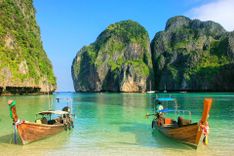Brief history
Ayutthaya takes its name from the Indian city of Ayodhya (Sanskrit for “invincible”), the legendary birthplace of Rama, hero of the Ramayana epic. It was founded in 1351 by U Thong – later Ramathibodi I – after Lopburi was ravaged by smallpox, and it rose rapidly through exploiting the expanding trade routes between India and China. Stepping into the political vacuum left by the decline of the Khmer empire at Angkor and the first Thai kingdom at Sukhothai, by the mid-fifteenth century Ayutthaya controlled an empire covering most of the area of modern-day Thailand. Built entirely on canals, few of which survive today, Ayutthaya grew into an enormous amphibious city, which by 1685 had one million people – roughly double the population of London at the same time – living largely on houseboats in a 140km network of waterways.
Ayutthaya’s golden age
Ayutthaya’s great wealth attracted a swarm of foreign traders, especially in the seventeenth century. At one stage around forty different nationalities, including Chinese, Persians, Portuguese, Dutch, English and French, were settled here, many of whom lived in their own ghettos and had their own docks for the export of rice, spices, timber and hides. With deft political skill, the kings of Ayutthaya maintained their independence from outside powers, while embracing the benefits of their cosmopolitan influence: they employed foreign architects and navigators, used Japanese samurai as royal bodyguards, and even took on outsiders as their prime ministers, who could look after their foreign trade without getting embroiled in the usual court intrigues.
In decline
In 1767, this four-hundred-year-long golden age of stability and prosperity came to an abrupt end. After more than two centuries of recurring tensions, the Burmese captured and ravaged Ayutthaya, taking tens of thousands of prisoners back to Burma. With even the wats in ruins, the city had to be abandoned to the jungle, but its memory endured: the architects of the new capital on Ratanakosin island in Bangkok perpetuated Ayutthaya’s layout in every possible way.
Visiting Ayutthaya – orientation and temple pass
The majority of Ayutthaya’s ancient remains are spread out across the western half of the island in a patchwork of parkland: Wat Phra Mahathat and Wat Ratburana stand near the modern centre, while a broad band runs down the middle of the parkland, containing the Royal Palace (Wang Luang) and temple, the most revered Buddha image, at Viharn Phra Mongkol Bopit, and the two main museums. To the north of the island you’ll find the best-preserved temple, Wat Na Phra Mane, and Wat Phu Khao Thong, the “Golden Mount”; to the west stands the Khmer-style Wat Chai Watthanaram, while to the southeast lie the giant chedi of Wat Yai Chai Mongkol and Wat Phanan Choeng, still a vibrant place of worship. The city’s main temples can be visited for a reduced rate when you buy the special six-in-one pass, which is available from most temple ticket offices.
Ayutthaya exhibitions
While visiting the branch of the Tourist Information Centre located in the old city hall, it’s well worth heading upstairs to the smartly presented multi-media exhibition on Ayutthaya, which provides an engaging introduction to the city’s history, an overview of all the sights, including a scale-model reconstruction of Wat Phra Si Sanphet, and insights into local traditional ways of life. On the other side of the staircase, there’s the Ayutthaya National Art Museum, which has depictions of animals, people and landscapes by Thai artists including a drawing in black ink by former Prime Minister Chuan Leekpai.
Thinking of travelling to Thailand? Start planning by learning about how to get to Thailand.





